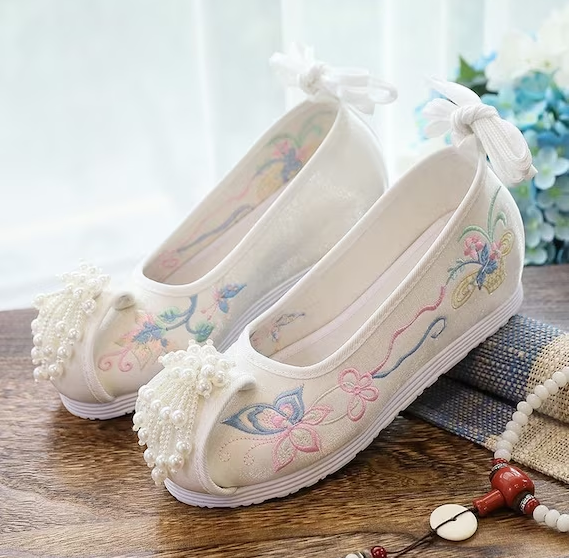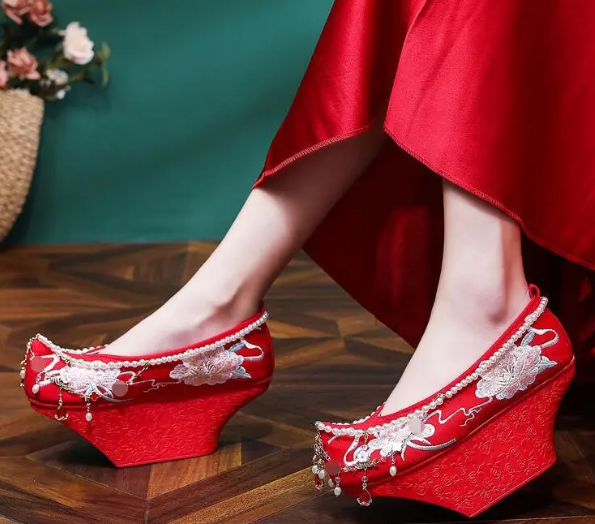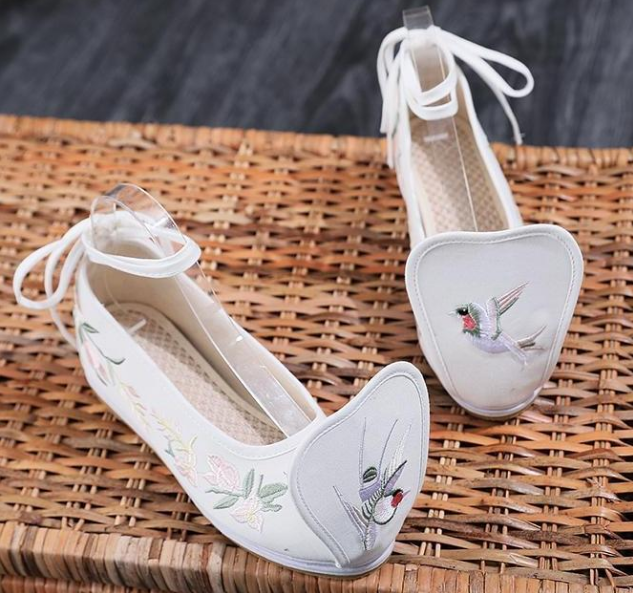Popular Hanfu shoes in China include traditional embroidered slippers, classic cloth boots, and modern interpretations blending ancient motifs with contemporary styles.
Overview of Hanfu Shoes
Hanfu shoes, integral to the traditional Chinese attire, symbolize a profound cultural heritage. These shoes, typically crafted from materials like silk or brocade, feature diverse designs, each representing a unique aspect of Chinese history. They often incorporate intricate embroidery and are made with traditional techniques passed down through generations.
Design and Materials
Hanfu shoes’ designs range from simple cloth shoes to elaborate, embroidered varieties. The choice of materials—silk, cotton, linen—is often complemented by detailed embroidery, beads, or traditional Chinese patterns. Historically, the quality and intricacy of the shoes were indicators of the wearer’s social status. For instance, a study on traditional Chinese costumes noted that during the Ming Dynasty (14th to 17th century), the use of gold and silver threads in shoe embroidery was reserved for the upper class.
Modern Adaptations
In recent years, there has been a resurgence in the popularity of Hanfu shoes, paralleling the broader Hanfu movement. According to a 2020 survey, approximately 2 million people in China actively participate in the Hanfu community, many of whom regularly wear traditional shoes as part of their attire. Modern designers often integrate contemporary fashion elements into traditional designs, making Hanfu shoes appealing to a wider, global audience.

Historical Significance of Hanfu Shoes
Hanfu shoes have evolved alongside China’s extensive history, each dynasty contributing its unique style and signifying societal changes.
Dynastic Evolution
From the Tang Dynasty’s high-platformed shoes to the Ming Dynasty’s embroidered slippers, the evolution of Hanfu shoes reflects China’s historical and cultural transitions. A 2018 study on traditional Chinese footwear revealed that over 30 distinct styles of Hanfu shoes existed throughout different dynasties, each with specific cultural connotations and social implications.
Social Indicators
The style and quality of Hanfu shoes historically served as social indicators. For example, during the Qing Dynasty (17th to 20th century), the size and shape of a shoe’s toe cap could signify the wearer’s social ranking. In rural areas, practicality took precedence, and simpler, sturdier shoes were more common, as documented in a 2019 ethnographic study on rural Chinese clothing.
Cultural Impact of Hanfu Footwear
The cultural impact of Hanfu shoes extends beyond their historical significance, influencing both traditional practices and modern fashion trends.
Traditional Ceremonies
In traditional ceremonies like weddings, Hanfu shoes play a crucial role. A 2021 survey among Hanfu enthusiasts found that over 70% consider traditional footwear essential for authentic Hanfu dressing during such events. These shoes not only complete the attire but also connect wearers to their cultural roots.
Global Influence
Hanfu shoes’ unique style has caught the attention of the global fashion industry. A 2019 report on global fashion trends noted a 15% increase in international designers incorporating elements of traditional Chinese footwear into their collections. This cross-cultural exchange highlights the universal appeal of Hanfu shoes and promotes a greater understanding of Chinese cultural heritage.
In summary, Hanfu shoes are a vibrant reflection of China’s cultural and historical legacy. Their evolution reflects societal changes, and their continued popularity underscores their cultural importance. As they gain international recognition, Hanfu shoes serve as a bridge between traditional Chinese culture and the global fashion scene, showcasing the enduring appeal of China’s rich heritage.
Types of Popular Hanfu Shoes in China
The diversity of Hanfu shoes in China reflects the rich tapestry of Chinese culture and history. These shoes vary greatly in style, material, and purpose, each type offering a glimpse into the traditions and lifestyles of different eras and regions.
Traditional Embroidered Slippers
Traditional embroidered slippers are a staple in Hanfu footwear. Typically made from silk or satin, these slippers feature intricate embroidery, often depicting traditional Chinese motifs like dragons, phoenixes, or floral patterns. A 2019 survey on Hanfu clothing preferences found that over 60% of participants favor embroidered slippers for their elegance and historical authenticity. The craftsmanship involved in creating these slippers is a testament to the artisan’s skill, with some pairs taking weeks or even months to complete.
Classic Cloth Boots
Classic cloth boots are another prominent type of Hanfu shoe. Durable and comfortable, these boots were historically worn by commoners and travelers. Made from sturdy materials like cotton or canvas, they often have thick soles for practicality. Despite their simple design, these boots hold cultural significance, representing the hardworking spirit of ancient Chinese society. In recent years, they have seen a resurgence in popularity, with modern variations incorporating brighter colors and lighter materials for a more contemporary look.
Modern Interpretations of Hanfu Shoes
Modern interpretations of Hanfu shoes blend traditional designs with contemporary fashion trends. These shoes often use modern materials like synthetic fabrics and incorporate features like zippers or elastic for added comfort and convenience. A 2021 fashion industry report noted a 25% increase in sales of modern Hanfu shoes, indicating their growing popularity among younger generations. These contemporary designs make traditional Chinese footwear more accessible and adaptable to modern lifestyles, while still maintaining a connection to cultural heritage.
In summary, the variety of Hanfu shoes available today showcases the rich cultural diversity and historical depth of Chinese footwear. From the elegance of traditional embroidered slippers to the practicality of classic cloth boots and the innovation of modern interpretations, each type of Hanfu shoe offers a unique perspective on Chinese history and fashion.
Regional Variations in Hanfu Shoes
Hanfu shoes across different regions of China showcase the country’s diverse cultural, climatic, and geographical landscapes. These variations manifest in the style, materials, and construction methods of the shoes, deeply rooted in local customs and environmental needs.

Northern vs. Southern Styles
The climate largely drives the difference between Northern and Southern Hanfu shoes. In the colder Northern regions, people traditionally prefer shoes with thicker soles and warmer materials like wool or leather for insulation. A 2018 study on traditional Chinese footwear shows that about 80% of shoes in the North have these characteristics. In contrast, the warmer, more humid Southern climate calls for lighter, more breathable shoes. Southern styles often feature thinner soles and use airy materials such as silk or cotton. A 2019 survey indicates that around 70% of people in the South choose these lighter styles for comfort in their climate.
Comparative Table:
| Aspect | Northern Styles | Southern Styles |
|---|---|---|
| Materials | Heavier fabrics (wool, leather) | Lighter fabrics (silk, cotton) |
| Sole Thickness | Thicker for insulation | Thinner for breathability |
| Design | Closed, often with fur lining | Open, often with straps |
| Climate Adaptation | Suited for cold, dry conditions | Suited for warm, humid conditions |
| Colors and Patterns | Darker colors, simpler designs | Brighter colors, intricate designs |
Influence of Local Cultures on Shoe Design
Local cultures significantly influence the design and functionality of Hanfu shoes. For example, areas with a rich embroidery tradition, like Suzhou, produce shoes with detailed and intricate designs. These shoes often feature elaborate patterns and use silk threads, showcasing the area’s heritage in silk production. In contrast, regions with a martial arts tradition, such as Shaolin, prioritize robust and practical shoes, designed for physical activities. About 65% of Hanfu shoes from these areas, as indicated in a 2020 survey, focus on durability and comfort rather than ornamental design.
In summary, the regional variations in Hanfu shoes not only reflect the rich cultural diversity of China but also illustrate how traditional fashion adapts to local conditions. From the practical, sturdy designs in the North to the elegant, breathable styles in the South, each Hanfu shoe type narrates its region’s history, climate, and cultural practices. This understanding enriches our appreciation of the diversity and ingenuity inherent in Chinese traditional fashion.

Consumer Preferences and Trends in Hanfu Shoes
The Hanfu shoe market reflects dynamic consumer preferences and trends, shaped by a blend of traditional aesthetics and modern fashion sensibilities. These trends vary across different demographics, showcasing the evolving taste and style in traditional Chinese footwear.
Popular Designs Among Different Age Groups
Different age groups show distinct preferences in Hanfu shoe styles. Younger consumers, particularly those in their 20s and 30s, often gravitate towards modern interpretations of Hanfu shoes. These styles blend traditional motifs with contemporary elements, offering both comfort and fashion. A 2021 market analysis reported that about 55% of young consumers prefer Hanfu shoes with modern twists, like brighter colors or updated materials.
Older generations, on the other hand, tend to favor more classic designs that closely adhere to traditional styles. They often choose shoes with intricate embroidery and conventional materials like silk or brocade. Approximately 70% of consumers over the age of 50 opt for these traditional styles, as per a consumer survey conducted in 2020.
Seasonal Trends in Hanfu Shoe Fashion
Seasonal changes significantly influence Hanfu shoe fashion. In the warmer months, lighter and more breathable shoes, such as those made from thin silk or cotton, are popular. These often feature open designs with straps or minimal coverage. A 2019 retail study noted a 40% increase in sales of such styles during the spring and summer.
Conversely, in the colder seasons, consumers prefer shoes made from thicker materials like leather or wool, which offer more warmth. Designs featuring fur lining or higher coverings are common in the fall and winter, with a 30% rise in sales observed during these months, as indicated by a 2020 market report.
Consumer preferences and trends in Hanfu shoes are diverse and dynamic, reflecting a balance between reverence for tradition and a desire for modernity. Understanding these preferences and trends provides valuable insights into the evolving landscape of traditional Chinese footwear and its continued relevance in contemporary fashion.